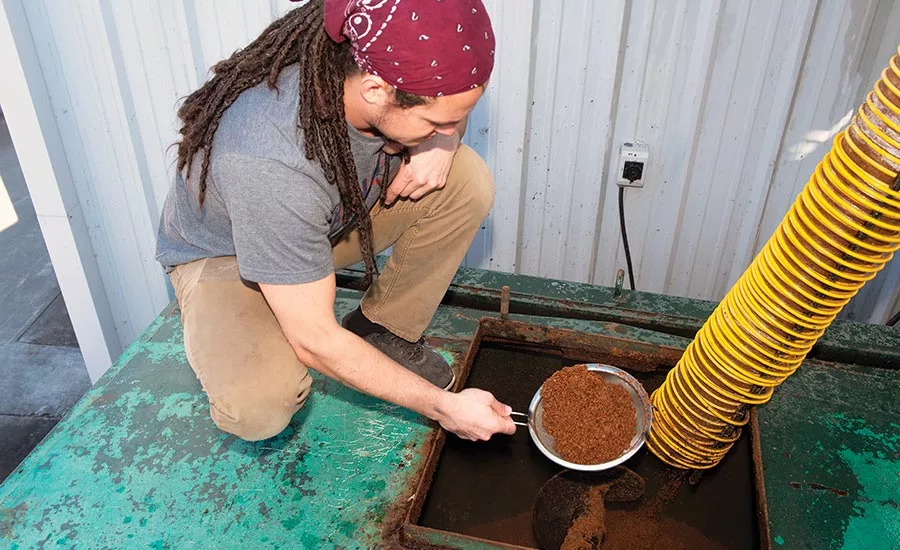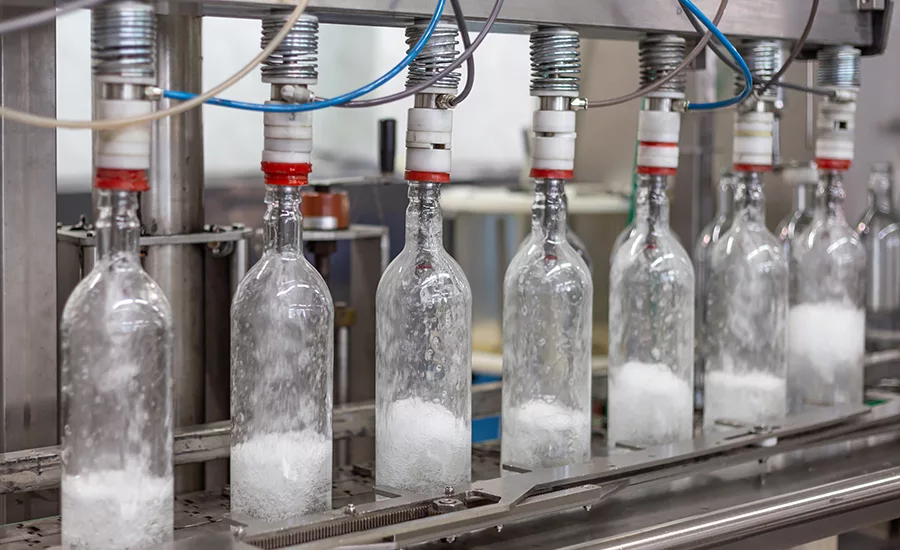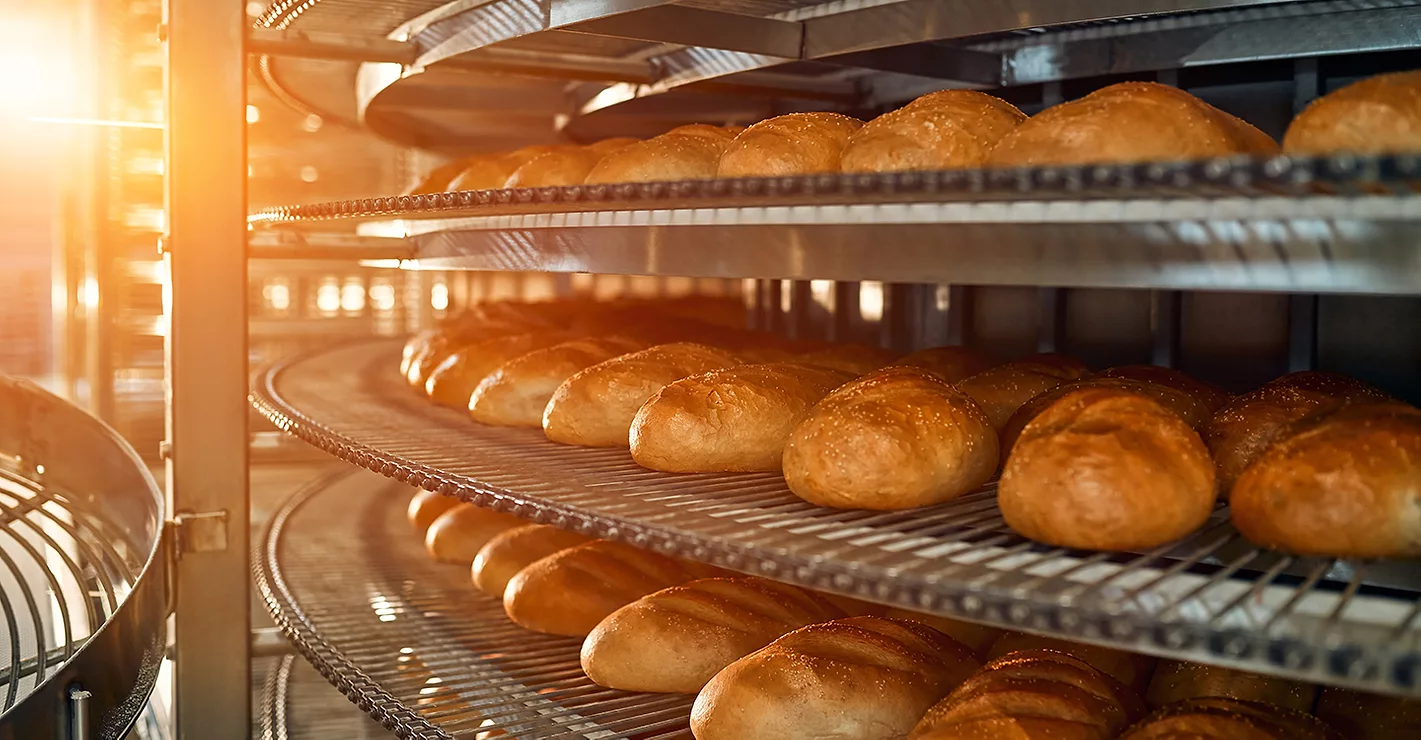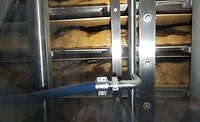Dry Processing
Whiskey distiller uses centrifugal sifter to recover liquid sour mash
With Kason sifter, Bendt Distilling turns spent grain byproduct into saleable livestock feed

Oversized grain solids exit through a downspout into an enclosed container. Recovered liquid (sour mash) gravity feeds through the center discharge, is stored and added to subsequent fermentation batches.
Photo courtesy of Bendt Distilling Co.

With approximately 80% moisture content, dewatered grain called stillage is used for animal feed.
Photo courtesy of Bendt Distilling Co.
Founded in 2012 by Natasha and Ryan DeHart, Bendt Distilling produces 1,200 barrels per year of straight whiskeys and whiskey blends using traditional distillation methods. Grains including wheat, rye, barley malt, oats, corn and triticale (a hybrid of wheat and rye) are ground to the consistency of coarse flour, then mixed with water, cooked, mashed and fermented. After fermentation, the strip run (first round of distillation) separates out the alcohol from the fermented mash. The remaining grain/water mixture, called stillage, consists of water containing 5% to 10% grain solids.
In its watery state, the stillage is a waste product to the distillery but contains enough grain and nutrients to be useful to farmers as livestock feed. Originally, Bendt pumped the stillage into a 20-cubic yard disposal container for pickup by farmers at no charge. This saved the company disposal costs as long as the stillage was collected. If it wasn’t, the company had to pay to have it hauled away.
In researching a solution, Ryan DeHart says he read about another distillery’s use of a centrifugal sifter to dewater stillage. He contacted the manufacturer, which evaluated Bendt’s application and recommended a Kason model MO-3BRG.
Sifting Out Grain Solids
Accumulating in a 10,000 gal (38,000 L) holding tank, the stillage is pumped roughly once per week into the centrifugal sifter. The water/grain mixture passes into the sifter’s horizontally oriented cylindrical screening chamber where rotating helical paddles accelerate the mixture against the screen by centrifugal force. Liquid passes through the screen, exits through a flanged discharge chute at the base of the sifter and flows into discharge piping.
Oversize grain solids are propelled along the cylindrical housing until they exit the downstream end of the cylinder and gravity feed into a 20 cubic yard (15.3 cu m) enclosed container. The centrifugal sifter operates at a rate of 30-40 gal/min (114 to 151 l/min), so emptying the tank takes four to five hours.
After dewatering, the grain still contains about 80% water but has a texture “you can hold in your hand,” DeHart says. A full container holds about 15 tons (13.6 m.t.) of grain, which is the yield of 20,000 gal (75,708 L) of stillage. The liquid, called sour mash, is recovered and stored to add to subsequent fermentation batches. “Using sour mash saves water, provides flavor consistency and naturally adjusts the pH,” DeHart says.
Ease of cleanout was a big factor in choosing the sifter, DeHart says. “We can clean it quickly, getting to all the pieces. With the three-bearing design, the front of the sifter opens for cleaning and changing parts. Internal components slide freely from the shaft.”
Compact design and low power usage were also important to DeHart. The 3 hp (2.2 kW) motor and the sifter’s heavy-duty construction are installed outdoors, and DeHart says he appreciates that the unit is relatively quiet.
Partnering with a national feed company, the distillery worked out an agreement with a local cutting horse farm to take the spent grain. Under a profit-sharing agreement with the feed company, the distillery receives income in addition to having the spent grain hauled away at no cost. The sifter has provided a “win-win” solution, DeHart says. “A waste byproduct for us is a useful product for somebody else.”
For more information, visit www.kason.com.
Looking for a reprint of this article?
From high-res PDFs to custom plaques, order your copy today!








